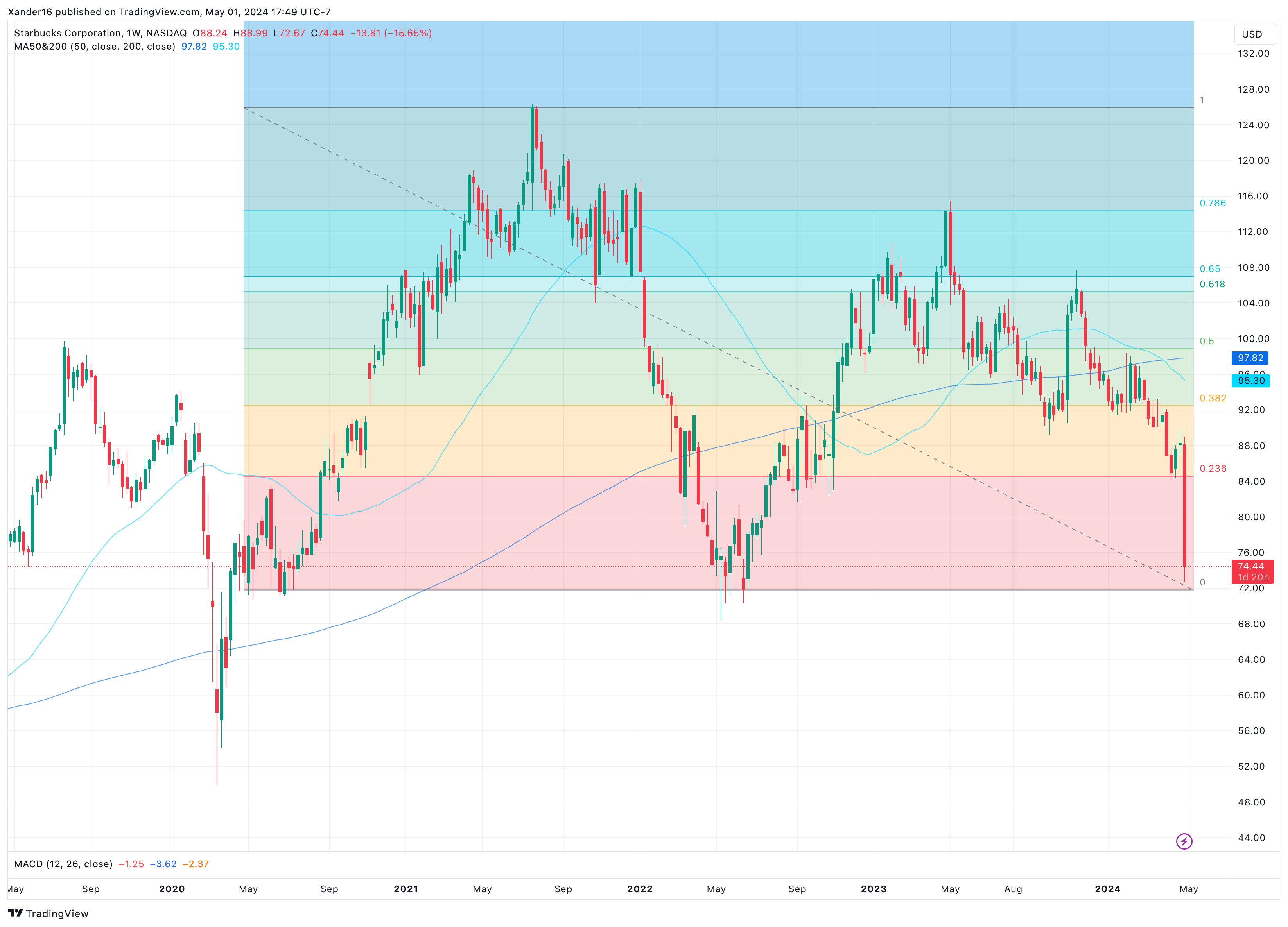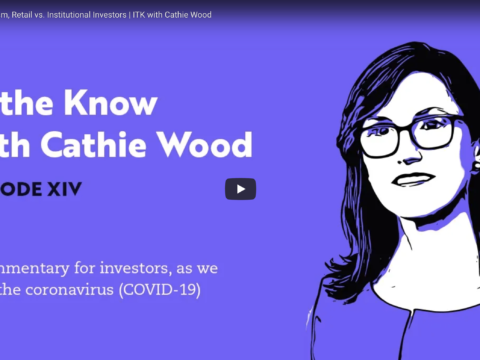Every once in a while I publish a free investment research article to show what subscribers regularly get to read.
Here’s the article on Patreon.
There is also a free tier available in my Patreon that I post occasional market news, opinions and research articles to. Or follow along on X.
$SBUX Price at close on May 1, 2024 = $74.44
Company Profile: coffee retailer, roaster, marketer, Seattle’s Best, Teavana
Starbucks Corporation, together with its subsidiaries, operates as a roaster, marketer, and retailer of coffee worldwide. The company operates through three segments: North America, International, and Channel Development. Its stores offer coffee and tea beverages, roasted whole beans and ground coffees, single serve products, and ready-to-drink beverages; and various food products, such as pastries, breakfast sandwiches, and lunch items. The company also licenses its trademarks through licensed stores, and grocery and foodservice accounts. The company offers its products under the Starbucks Coffee, Teavana, Seattle’s Best Coffee, Ethos, Starbucks Reserve, and Princi brands. Starbucks Corporation was founded in 1971 and is based in Seattle, Washington.
Sector // Consumer Discretionary | Hotels, Restaurants & Leisure
- Overall Quality Score = 58.5 out of 100
- Strike Price = US$72 at 50% Margin of Safety
(or $96.48 if you prefer a 33% MoS for this stock at this point in the market cycle) - 5 Year Price Target = $158.83 (113.4% gain) at a PS Ratio of 2.5
(current ratio is 2.74, 5 year average is 3.9, sector average is 0.85) - Future Growth Rate of the Stock = 13.3%
(expected CAGR over 5 years based on growth of EPS + revenue * multiplier) - Lifecycle Stage = purple // Dividend = 2.58%
- Market Cap = $99.99 billion
- Past CAGRs
- 5 Year = 2.7% | 10 Year = 9.5% | 20 Year = 11.6% | Average = 8.0%
NOTE:
- If the company and/or the economy performs well the Price – Sales Ratio could increase and the stock price would exceed the 5 year target. The inverse is also possible.
- The annual EPS and revenue growth rates can fluctuate. EPS growth is more important. The Compound Annual Growth Rate is an expected average over the next 5 years.
- Companies go trough lifecycle stages
- Purple = mature | lower growth and volatility, often with dividends and buybacks
- Blue = prime | high growth but volatile, moats are established but not entrenched
- Green = youthful | high growth but volatile, on the cusp of profitability and FCF+
- Orange = toddlers | high revenue growth, very volatile, not yet profitable
- If the past average CAGR is 8% and the dividend is 2% then your total return is 10% which is about the average return of the S&P 500, the benchmark.
Margins & Other Metrics:
- Gross Profit Margin = 27.7%
- 5 Year Revenue CAGR = 6.3%
- 5 Year Net Income CAGR = 2.8%
- Operating Income Margin = 15.3%
(2 years ago it was 13.8%, 5 years ago it was 14.8%) - Price – Free Cash Flow Ratio = 21.45
- Price – Earnings Ratio = 18.56
- Cash to Operating Expense Ratio = 68.9%
- Long Term Debt to Total Asset Ratio = 52.9%
- Return on Invested Capital = 24.8%
More Info @ GGI Strike Price List > WATCHLIST > Ultimate AWP // Comparables & Backups > Stalwarts
// THESIS
Chances are you’ve been to a Starbucks at some point in the past year. If you’re a Gen Z perhaps in the past week and consider it the 7th Most Magnetic Brand.
Personally I think Starbucks coffee tastes burnt and it’s nowadays over-priced and I have no need for empty-calorie fancy caffeine drinks that cost nearly as much as a cocktail. But occasionally I will go there as they are often convenient. There’s one in seemingly every neighbourhood around the planet and they monopolize malls and airports. But unless things have changed, the food tends to be sub Tim Hortons level and I generally don’t go for just a coffee, I go for food and a coffee, whether its TH level or a foodie hot spot.
Starbucks has a brand moat and with that pricing power, but I don’t think their brand is as rock solid as it was 10+ years ago. There are a plethora of options out there in all stripes and price points for getting a coffee and perhaps a snack. Obviously there are still plenty of Starbuckstan’s out there but my guess is they skew younger and thus can be fickle. Is anyone over the age of 28 still such a fan of Starbucks they won’t substitute (like an iOS vs Android person) or is it just convenience and you go there because there is a location closer to you than anything else and it requires no brain power?
In the modern quest to make money selling caffeine, I also have to wonder if energy drinks like Celsius, branded as health and wellness products, are taking a bite, er sip, out of coffee sales.
Anyways, if you agree with me you can probably move on but if you think Starbucks is the schizz and the mad price drop today, in response to yesterdays earnings call, is the opportunity of a life time, then read on.
The earnings call was kind of bad. Q2 2024 revenue of $8.6B, missing estimates by almost $600M. Revenue down 1.8% YoY.
Total transactions in all geographies combined were down 6% from a year ago. This means that people weren’t just downgrading their order from latte to americano, for financial reasons, they were choosing other options, whether it was at home or elsewhere. They mentioned a “cautious consumer.”
Above I mentioned that OpInc margin was 15.3%. That is for the trailing twelve months (TTM). The past four quarters were 12.0%, 15.2%, 17.2% and 16.6%. A year ago it was 13.6%, 13.8%, 13.7% and 15.4%. It fluctuates, but this most recent quarter was bad.
Yes times are tough, inflation and what not. China still has economic issues. But in this past quarter Starbucks had a geopolitical issue. I haven’t fully researched it, but pro-Palestinian protesters boycotting is not good for business. (It’s something to do with unions and social media.) I presume Starbucks isn’t anti-Palestine so this too shall pass when they make amends and their margins and revenue and thus earnings will come back to equilibrium.
Starbucks CEO Narasimhan:
In a highly challenged environment, this quarter’s results do not reflect the power of our brand, our capabilities or the opportunities ahead….it did not meet our expectations
Earnings call transcript for those keeners out there: https://seekingalpha.com/article/4687827-starbucks-corporation-sbux-q2-2024-earnings-call-transcript
The EPS also missed by $0.12 and was down 1.8% YoY. Consensus estimate was $0.80 but actual was $0.68 and thus the beat down on the stock.
At the moment estimates for the next earnings call in late July is for an EPS of $0.98 and revenue of $9.42B. Cautious optimism for Starbucks after this low point.
Starbucks opened 364 new stores in Q2, ending the quarter with 38,951 stores. 52% are company operated and 48% are licensed stores. 61% of all stores are in the US and China. There was growth in Latin America and Japan but the international growth story is basically over for Starbucks. They are already global.
The Starbucks Rewards loyalty program seems to work. The 90-day active members in the U.S., was 32.8 million, up 6% year-over-year.
I’m a little skeptical about the brand but it has been a great company for 50 years now and despite the lower growth it is a bit of a dividend aristocrat.* If you love your venti-pumpkin-frappe-whatever, it appears to be a good buy time.
However, I should mention another concern; their balance sheet. Total Equity is negative. This is weird, but apparently not so much for restaurants. McDonalds also has that. Chipotle doesn’t. Just sayin’. That stock has been tearing for a decade or more … but I’m starting to hear some negativity. Their efforts to be super efficient are backfiring as quality and service are going downhill. Story for another day.
I haven’t analyzed any other restaurants for comparables in my spreadsheet yet, but the Cash to Operating Expense Ratio and Long Term Debt to Total Asset Ratio were not what I expected. I think it is symptomatic of the industry but Starbucks are packing more debt and less cash than what makes me comfortable.
I asked Google Gemini what they thought about the Total Equity of Starbucks:
Starbucks’ negative total equity on their balance sheet primarily stems from two main factors:
- High Debt: Starbucks has a significant amount of debt compared to its assets. This debt was mainly accumulated through:
- Acquisitions: Funding acquisitions like the La Boulange bakery and Teavana chain.
- Share buybacks: Repurchasing their own shares to return value to shareholders.
- Dividends: Paying out regular dividends to investors.
- Retained Earnings Deficit: Starbucks has experienced periods of net losses or profits insufficient to cover the dividends and share buybacks. This leads to a negative balance in retained earnings, which is part of shareholders’ equity.
Here’s a breakdown of the consequences:
- Debt-to-Equity Ratio: This ratio, currently exceeding -170% for Starbucks, indicates that the company’s liabilities significantly outweigh its equity. This raises concerns about its financial stability and ability to manage debt.
- Financial Risk: High debt levels increase the risk of defaulting on loan payments if the company experiences financial difficulties.
However, it’s important to consider additional points:
- Profitability: Despite negative equity, Starbucks remains profitable, generating positive cash flow that helps manage the debt.
- Interest Coverage Ratio: This ratio suggests their earnings effectively cover interest payments on the debt.
- Industry Comparison: Negative equity isn’t uncommon in the restaurant industry, where companies often prioritize shareholder returns through debt-funded activities.
While Starbucks’ negative equity raises financial concerns, it doesn’t necessarily imply imminent financial distress. However, it highlights the company’s reliance on debt and the need for careful financial management to ensure long-term sustainability.
*Google Gemini is saying that Starbucks has experienced periods of insufficient profits to cover dividends. The average dividend payout ratio (div/s / EPS) for the past 10 years is ~50% but in 2020 it was 207%. Their Total Debt jumped for $11.2B to $25.3B that year but it was in 2019 that Total Equity nosedived into negative territory. In 2018 they had FCF/s of $7.20 or triple what they had in 2017 so it seems they went buyback shopping. It would appear they over did it but that CEO is no longer there. The stock went from sub $50 in mid-2018 to almost $100 in mid-2019.
In Q1 2019, Starbucks expended approximately $2.17/share to repurchase shares. Compare this to their quarterly earnings of $0.53/share. It’s clear that their repurchase expenditure exceeds their earnings, leading them to have negative “retained earnings” for the quarter. Source
It should be noted that current Total Debt is maintaining at $25.2B so that insufficient profit may be just a black swan event. Still I wouldn’t want those interest payments these days.
Howard Schultz was a great CEO but the board may have hired a clown or two after he retired in 2017 until he returned as interim CEO in 2022. Hopefully they got it right in April 2023 when they hired Laxman Narasimhan, the CCO of PepsiCo.
// CHART
My current trade conviction = 3.5 out of 5
Trade Entry Price = $76
(subject to change at a whim due to market vicissitudes)
$SBUX today almost hit major support at $71, the low of the post-covid sell-off in 2021-22. If it goes below that we’re basically into pre-2019 prices.
After the crash today (earnings call was yesterday evening) we are basically at that support and at strike price.
RSI is now under 20, MACD well below 0 and the 50 and 200 day moving averages are well above. We also hit a 52 week low today.
If you like this company here’s your chance. But it’s more of a dividend than a growth story now.
The question is how long will it need to consolidate below the 0.236 fibonacci in the $72 – $84 range?






